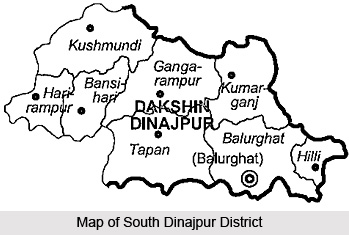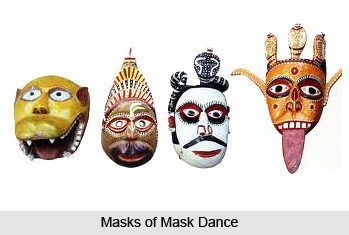South Dinajpur District or Dakshin Dinajpur District is a district of West Bengal. This district is created on 1 April 1992 by the division of the erstwhile West Dinajpur district. This district comprises two subdivisions: Balurghat and Gangarampur.
 History of South Dinajpur District
History of South Dinajpur District
The history of South Dinajpur District defines the fragmentation of this district at the time of the partition of India, was split up into West Dinajpur district and East Dinajpur District. The East Dinajpur district, now called Dinajpur, became part of East Pakistan, now Bangladesh. The West Dinajpur district was enlarged in 1956, when States Reorganisation Act recommendations were implemented, with the addition of some areas of Bihar. The district was bifurcated into Uttar Dinajpur and Dakshin Dinajpur on April 1, 1992.
Demography of South Dinajpur District
According to the Population Census 2011, South Dinajpur District had a population of 1,676,276 of which male and female were 857,199 and 819,077 respectively. In 2001 census, South Dinajpur district had a population of 1,503,178. Out of which the males were 770,335 and remaining 732,843 were females. South Dinajpur District population constituted 1.84 percent of total population of India. There was change of 11.52 percent in the population compared to population as per 2001. The population density of South Dinajpur district for 2011 is 755 people per sq. km. The average literacy rate of South Dinajpur in 2011 was 72.82 percent compared to 63.59 percent of 2001. The total literates in South Dinajpur District were 1,083,685. Out of which the male and female were 596,474 and 487,211 respectively. The average national sex ratio in India is 940 as per latest reports of Census 2011 Directorate. In 2011 census, child sex ratio is 957 girls per 1000 boys compared to figure of 966 girls per 1000 boys of 2001 census data.
Education of South Dinajpur District
The overwhelming dependence on agriculture and the threats of unemployment has retarded the growth of the district. But in spite of all these hindrances, the district has made progress in the field of education. The Literacy campaign was launched in the year of 1993, with the solemn aim of eradicating literacy in the region. Later due to the implementation of the District`s primary education program (DPEP), the total process of elementary and primary education has been augmented. New school buildings and the additional rooms have been provided under the program so that the adequate space is available for the schoolrooms. Community mobilization programs have already been completed for the primary teachers. Through the program of DPEP, the district is gradually progressing to the desired aim of Universal elemental education. Although the region is making a prominent advancement in the field of the elemental training, no endeavor has been made for the growth of the higher education.
Culture of South Dinajpur District
Though South Dinajpur District represents a multi-ethnic culture as it had been colonized by a number of civilizations, it is the local folk culture, which still survives. The important folk culture of the region is called "khan" mainly performed by the rural communities and the scheduled Caste & scheduled tribes.
Khan Song
Khan is a kind of folk opera, songs intertwined wit the dialogues. Songs used to be composed and tuned by the participants. The language is the local dialect of Bengali. It actually deals wit the scandalous event or illicit act committed by any local people. Some of the notable khan palas are "Cyclesari", "Buddhasari" etc.
 Natua Dance
Natua Dance
Natua is a kind of opera mainly based on the divine love of Radha & Krishna.The folk songs called Jang gan composed in Dinajpuri and surajpuri dialect is practiced among the locals.
Mask Dance
Locally called "Mokha Nach" is the common festival among the people of the rural areas, which represents the various ethnic groups. The masks are made of the woods locally available. Halna -Halnani is a kind of folk opera Where Halna is a male and Halnani is a female
Folk artists of the region equally participate in the cultural programs organized by the Government. In the annual Teesta -Ganga Utsab, the folk cultural performances share a significant part.
Economy of South Dinajpur District
The whole region of South Dinajpur District falls under the "backward" area of Due to the unavailability of required mineral resources and the adequate infrastructure; industries are not prospering in the region. Hence the region is marked under the "non industry" Zone of West Bengal. The industries are mainly the medium and small-scale industries. The cottage and handloom sectors deserve special mention. Rice mill, Mini rice mills, Chira mills, Wheat grinding and husking, Noodles and Vermicelli making mills, mustard oil manufacturing mills and jute made dhokra are the important industry of the region. Four rivers - Atreyee, Punarbhaba, Tangon and Brahamani drain the district and the alluvium carried by those rivers constitutes the region of Dakshin Dinajpur district, essentially an agricultural district. In an agriculture based rural economy agro -trade is the principal source of income. Several development programs have been undertaken to induce the economic upliftment of the district. The Government in collaboration with the East India Co operative Agro Farming and Marketing Society Ltd. has initiated the programs of agro-trade. By increasing the productivity of Milk, meat, egg and other agricultural products and their proper marketing etc are the agenda of the development programs. The development programs provide the social and economic security to the poor and the needy, endowing them with employment in the agricultural sectors.
The development agenda and the small-scale industries however are not successful enough to wipe away the social & economic hindrances of the district.
Tourism of South Dinajpur District
The history of Dakshin Dinajpur, which constitutes the magnificent past of the former Dinajpur district has endowed the region with a profuse storage of rich cultural heritage. From the different antiques and the inscription unexcavated till date, it is evident that the place is very interesting historically.
Hilli Block
Hilli Block is the famous international Indo- Bangladesh Border Check post. The Bangladesh Border on the side of the Hilli undoubtedly is an important tourist center. The PWD bungalow is the only accommodation for the tourist here.
Sarongbari
Sarongbari is an important tourist spot, the key attraction of which is the small forest. It is the remarkable picnic spot for its scenic beauty. The Balurghat division is invested with reflective historical importance. It was the place, which solely participate in the struggle for independence. Therefore the past history of the place makes it a seat of attraction for visitors. However the small forest of the Balurghat division is no less an alluring site, for those loving forest.
College Museum of Balurghat
The College Museum of Balurghat is evidently of immense interest because of its collection of coins, inscriptions, terracotta figurines of the past kings, which bears the testimony of the past heritage of the region.
Khanpur
Khanpur is another significant historical site because the Tebhaga Movement originated in the region. Bolla Kali Temple, having a mythological story behind it, is undoubtedly a significant place for the pilgrims. In comparison to the north Dinajpur, the district of South Dinajpur is blessed with the places of historical importance for which it has been developed as an important tourist site of North Bengal.






